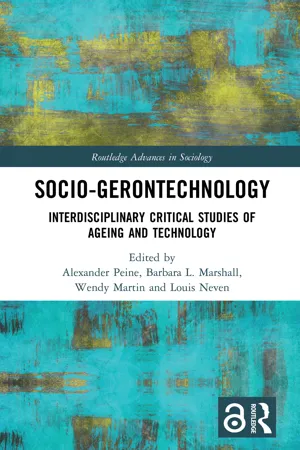
Socio-gerontechnology
Interdisciplinary Critical Studies of Ageing and Technology
- 262 pages
- English
- ePUB (mobile friendly)
- Available on iOS & Android
Socio-gerontechnology
Interdisciplinary Critical Studies of Ageing and Technology
About This Book
Social change in the twenty-first century is shaped by both demographic changes associated with ageing societies and significant technological change and development. Outlining the basic principles of a new academic field, Socio-gerontechnology, this book explores common conceptual, theoretical and methodological ideas that become visible in the critical scholarship on ageing and technology at the intersection of Age Studies and Science and Technology Studies (STS).Comprised of 15 original chapters, three commentaries and an afterword, the book explores how ageing and technology are already interconnected and constantly being intertwined in Western societies. Topics addressed cover a broad variety of socio-material domains, including care robots, the use of social media, ageing-in-place technologies, the performativity of user involvement and public consultations, dementia care and many others. Together, they provide a unique understanding of ageing and technology from a social sciences and humanities perspective and contribute to the development of new ontologies, methodologies and theories that might serve as both critique of and inspiration for policy and design.International in scope, including contributions from the United Kingdom, Canada, the United States, Australia, Germany, Norway, Denmark, Austria, the Netherlands, Spain and Sweden, Socio-gerontechnology is an agenda-setting text that will provide an introduction for students and early career researchers as well as for more established scholars who are interested in ageing and technology.
Chapters 3, 5, and 15 of this book are freely available as downloadable Open Access PDFs at http://www.taylorfrancis.com under a Creative Commons Attribution-Non Commercial-No Derivatives (CC-BY-NC-ND) 4.0 license.
Frequently asked questions
Information
Chapter 1 Socio-gerontechnology: key themes, future agendas
A critical approach to ageing and technology
Interdisciplinary studies of ageing and technology
Table of contents
- Cover
- Half Title
- Series Page
- Title Page
- Copyright Page
- Table of Contents
- List of figures
- Note on contributors
- Note on editors
- 1 Socio-gerontechnology: key themes, future agendas
- 2 Age, actors and agency: what we can learn from Age Studies and STS for the development of Socio-gerontechnology
- PART I Bridges: critical frameworks of ageing and technology
- PART II Encounters: empirical approaches to ageing and technology
- PART III Design: critical reflections and new approaches
- Index